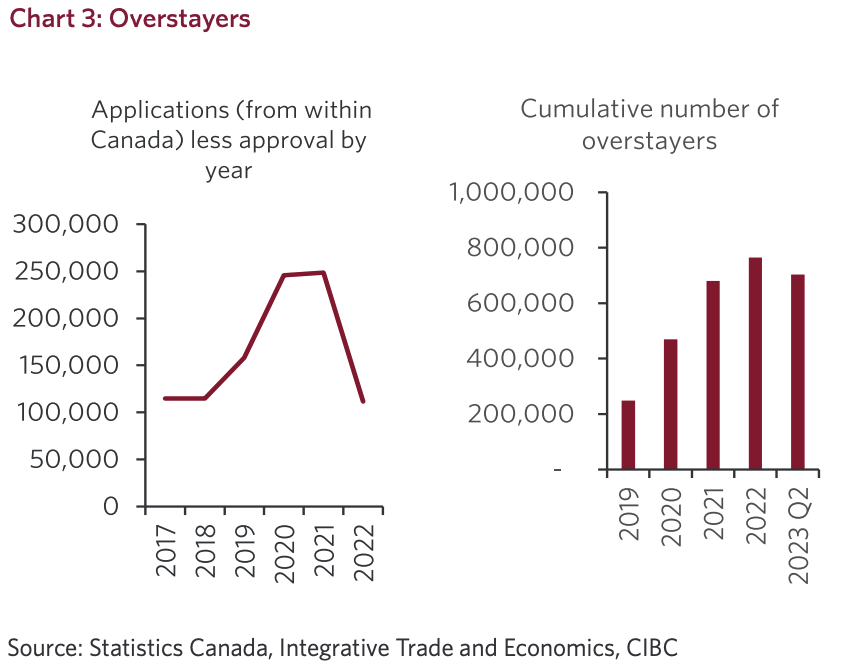Hidden Demand for Housing: Economists Estimate Up to One Million Non-permanent Residents Missing From Official Stats

As Canada grapples with a housing shortage, an underlying factor seems to have gone unnoticed: the true count of non-permanent residents (NPRs) residing in the country.
The official numbers, widely quoted and relied upon for policy planning, are underestimating the NPR population by nearly one million individuals. This revelation, brought to light by CIBC Capital Markets’ Managing Director and Deputy Chief Economist, Benjamin Tal, sheds new light on another factor impacting the country’s housing supply and affordability.
The implications
Tal notes forecasting population growth is a challenging yet essential endeavour as it impacts resource allocation and housing planning across provinces and municipalities.
“What if 10 years ago, we had known that Canada’s population would reach 40.2 million in 2023? We probably would have been better prepared, and the size of the housing shortage would have been smaller. But we didn’t know,” Tal points out.

Canada’s population projection for 2023 was off by a staggering 1.1 million, primarily due to an unexpected surge in NPRs and stronger-than-expected immigration, which, as Tal explains, translates to a housing demand miscalculation equivalent to over two years of building capacity. However, the economist’s analysis suggests that the actual gap might be even more significant.
“Things happen. Government policies and priorities change. But two measurement issues related to the counting of NPRs suggest that the size of the miss might be closer to 2.5 million — a full million larger than the reported miss.”
The census conundrum
Tal delves into the heart of the issue, uncovering a significant gap in the NPR counts reported by Statistics Canada. The 2021 census indicates roughly 925,000 NPRs, while quarterly estimates point to around 1.17 million.

Statistics Canada has previously acknowledged this discrepancy, Tal explains, as the 2011 census undercounted NPRs by more than 40 per cent. “Back then, the absolute number of NPRs was relatively small, so the undercounting did not have profound implications on population growth and housing market demand planning, unlike today’s situation.”
Although the gap has decreased to around 20 per cent, the absolute increase in NPR numbers in recent years has widened the divide once again, potentially reaching a shortfall of approximately 250,000 in 2021.
Tal explains two key factors contributing to this phenomenon: the inherent hesitance of students from certain countries to engage with government authorities hinders accurate reporting, and, secondly, the census’s methodology inadvertently excludes temporary foreign workers and student visa holders who struggle to navigate census instructions.
The unseen “overstayers”
Another crucial aspect emerges as NPRs’ “temporary” status becomes more permanent than expected. Statistics Canada’s exit assumption — that temporary residents (TR) would leave within 30 days of visa expiry — is proven inaccurate. A staggering 60 per cent of international students express a desire for permanent residency, leading to an increased number of overstayers. This trend is compounded by changes in work visas and growing employment opportunities, driving many NPRs to extend their stay while waiting for an invitation through the Express Entry Program.
Tal points out that there is no known administrative action by Immigration, Refugees and Citizenship Canada to remove these expired visa holders from Canada, nor a known mechanism to withdraw their employment or tax slip issuances by the CRA.
During the height of the pandemic, 2020 and much of 2021, expired TR visa holders were stranded due to travel restrictions, defying the anticipated exit timeline. In subsequent years, a significant proportion remained in Canada despite the reopening of international borders.
The hidden million
When tallying the undercounted NPRs and overstayers, the discrepancy reaches close to one million individuals. Though, as Tal notes, there are no official statistics available.
This revelation has significant implications for Canada’s housing affordability crisis, painting a graver picture than initially perceived. As policymakers and planners rely on these official numbers for decision-making, the shortage of available housing resources becomes even more pronounced.

A call to action
The economist writes, “The practical implication of that undercounting is that the housing affordability crisis Canada is facing is actually worse than perceived and calls for even more urgent and aggressive policy action, including ways to better link the increase in the number of NPRs to the ability to house them.”
Tal’s findings emphasize the urgency of reevaluating policy responses to address the hidden housing demand driven by NPRs. With the upcoming federal government’s fall fiscal update, he’s calling on bureaucrats to tackle this issue head-on and unveil a comprehensive strategy that aligns housing supply with the growing number of NPRs.
REM (Jordan Springay, August 31,2023)







